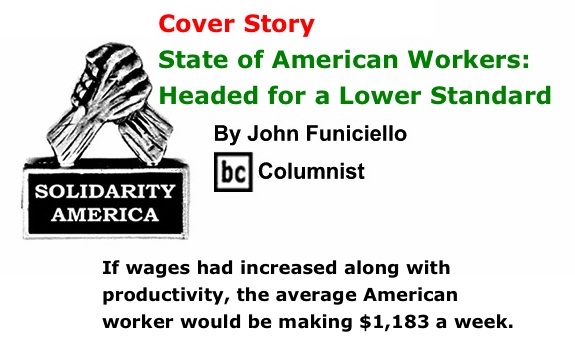




Pity the poor American worker.
Union and other labor leaders in the country are desperately trying to
find a way to resurrect the power of the people in the workplace and
trying to rescue it from the sharp decline that started about 40 years
ago.
At that time in the U.S.,the position of the middle class started its
downward slide. It was slow enough, though, that many of them didn’t
see what was happening, at least not right away.
A recent union publication pointed out “89 out of 100 workers don’t
have collective bargaining.” That means 89 percent of workers are not
represented by a union and it means they don’t have much power in the
workplace.
For those who are concerned about the health of the U.S. economy, that
statistic alone should reveal that there is no hyperbole in “gloom and
doom” economic forecasting. That’s because there actually is gloom and
doom and it’s a pall that has settled over American workers. The
numbers say that only 11 percent of American workers are union members
and, in the private sector, there are predictions that the percentage
of unionized workers, now at about 7 percent, is heading toward 5
percent.
Why should anyone care? Well, there are people
who care about this on a theoretical level (economists and some
politicians), but there are some 155 million workers (including the
unemployed) who are very concerned at a very personal level. They care
very much about their families and their communities and, although they
might not think of it in terms of having a union to represent them and
support them and ensure them a decent standard of living, what they do
know is that they are dropping inexorably to the lower rungs of the
economic ladder and all that that implies.
They know that they, along with other workers, have not only been
standing still in wages, but they have slipped backward and there is no
sign that this condition will improve anytime soon. In numbers from the
U.S. Bureau of Labor Statistics (BLS) that everyone can understand, it
is clear that wages, despite productivity gains, have been reduced over
the past four decades.
According to BLS numbers, the real (current dollars) weekly average
wage in 1947 was $462, and that number rose steadily over the next 20
years, until it was $731 a week in 1971. Ever since, however, the real
wage has dropped, until, in 2010, it stood at $637, nearly $100 less
than the average workers was earning in 1971. During all those years,
productivity has increased steadily and, if wages had increased along
with productivity, the average American worker would be making $1,183 a
week.
This has happened to workers across the board in the U.S. and the main
reason is that most workers have not had a union to represent them in
the workplace and demand a share in the much-increased productivity.
That’s what unions do: provide a voice in the workplace, demanding a
just share of what they produce, provide a measure of justice in
discipline and promotion, provide for equity in treatment regardless of
race, religion, gender, or sexual orientation. They do more, but that
is at the core of the function of a union.
Not surprisingly, the decline in real wages over the past 40 years has
occurred at about the same rate as the growth of the disparity in
wealth. In 2007, the richest 1 percent of Americans owned 34.6 percent
of the country’s total wealth, according to Senior Scholar Edward N.
Wolff, professor of economics at New York University and a research
associate at the National Bureau of Economic Research. In that same
year, the top 20 percent of Americans owned 85 percent of the wealth
and the bottom 80 percent owned just 15 percent of the nation’s wealth.
The distinction between income disparity and wealth disparity is
significant, but wealth disparity measures the amount of holdings
(homes, vacation properties, large investment portfolios, airplanes,
real estate, for example), and the disparity in wealth remains severe,
more than most other developed countries.
Unions mitigated that disparity for the first few decades after World
War II, but the forces of capital already had launched a virtual war
against workers and their unions, even against the very idea of unions.
At the same time, Corporate America and their CEOs (in the old days,
they were called “Robber Barons”) were busily funding right wing think
tanks and buying up news outlets, to blanket the country with
anti-union propaganda. Especially, they were busy influencing the
children and young students by placing their pamphlets and other
propaganda widely in schools, colleges, and universities. They heavily
influenced the writing of textbooks and funded “chairs” or entire
departments in universities, again with the intention of having a say
in how subjects are taught and monitoring the outcomes in subtle, but
effective ways. They still do and it’s not always subtle.
The AFL-CIO, one of two labor federations in the country, is attempting
to turn this behemoth around, but it is fighting the incredible power
of combined capital, manifested by the U.S. Chamber of Commerce, the
Business Roundtable, the National Association of Manufacturers, and the
American Legislative Exchange Council, to name a few. It plans to
address it at the annual convention later this year. In preparation, it
appointed earlier this year committees of workers and union leaders to
formulate ways to increase both membership in unions and the power of
workers at the bargaining table.
Any plan that organized labor comes up with
will have to be a much broader effort than has been traditional for the
past 50 years or so. Time and again, both local and national union
leaders have said, in effect, “we’re going to stick to wages, benefits,
and working conditions…we want our dues money to be spent on our
members only.” That has been and will continue to be the dirge of the
unions and the movement.
In the old days, before collective bargaining laws and the dues
checkoff, unions were more of a social movement than they have been
since World War II. They tended to address the needs of workers and
their families where they lived and were concerned about life in their
communities. So, while they demanded living wages and better working
conditions, they also took care of the sick and buried the dead. It has
been a long time since leaders of unions have thought in those terms.
Today’s unions must broaden their scope to include issues of war and
peace, economic justice for all (union or not), saving what is left of
the natural environment, the creation of a just and holistic food
system, and, perhaps most important of all, a full frontal defense
against the power of Corporate America, which has assumed control over
the years of greater and greater portions of our lives.
In all of these things just mentioned, organized labor has been divided
for a long time. Take for example the Vietnam War…it was a classic
division between the “hard hats” and those unions that had a broader
political view of the world. Today, issues like the Keystone XL
pipeline from Alberta, Canada, to Texas, separate one group of unions
from another. Even when there is some rational debate, afterwards there
remains disunity and that is the face shown to the people.
The power of Corporate America is that, although they repeat the mantra
“competition,” there is no competition among them when it comes to the
job of keeping workers in their place and driving down wages and living
standards. They are of one mind about this and they have succeeded and
they believe that they will continue to win this war they have declared
against a seemingly defenseless populace. Their concern is not to
“promote the general welfare,” as called for in the preamble to the
U.S. Constitution, but to promote their own welfare and to ensure that
they have as little competition from the people as possible toward that
end. In this, they have succeeded beyond their own dreams.
To recover, survive, and bring the benefits of national unity to the
people, organized labor has a monumental job ahead. It needs to counter
the colossal amount of money and power that is arrayed in front of
them. The union movement needs to teach the people that they are the 99
percent and that the 1 percent is what is standing in the way of
bringing change to a country that is in desperate need of reinventing
itself, to achieve what has eluded us so far: equality, justice,
fairness, a decent standard of living for all, and a conserved and
protected environment in which to work and live.
Anything short of this will see the American founders’ goal of a fair and just society fade away.

BlackCommentator.com Columnist, John Funiciello,
is a long-time former newspaper reporter and labor organizer, who lives
in the
 |






